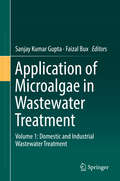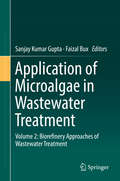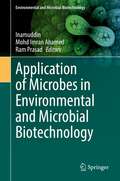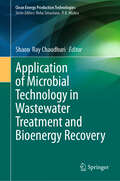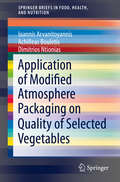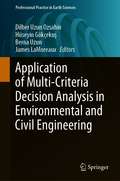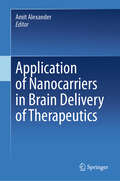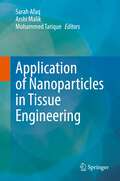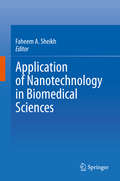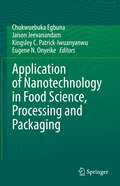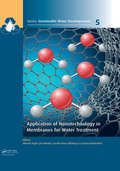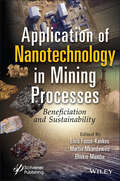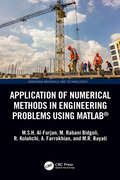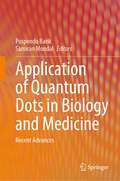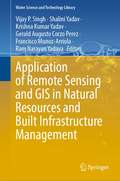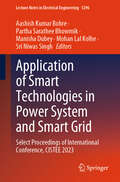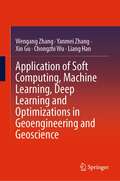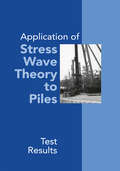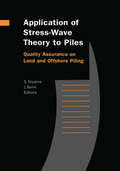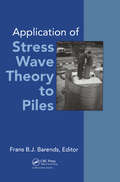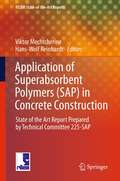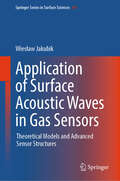- Table View
- List View
Application of Microalgae in Wastewater Treatment: Volume 1: Domestic and Industrial Wastewater Treatment
by Faizal Bux Sanjay Kumar GuptaThis two-volume work presents comprehensive, accurate information on the present status and contemporary development in phycoremediation of various types of domestic and industrial wastewaters. The volume covers a mechanistic understanding of microalgae based treatment of wastewaters, including current challenges in the treatment of various organic and inorganic pollutants, and future opportunities of bioremediation of wastewater and industrial effluents on an algal platform. The editors compile the work of authors from around the globe, providing insight on key issues and state-of-the-art developments in algal bioremediation that is missing from the currently available body of literature. The volume hopes to serve as a much needed resource for professors, researchers and scientists interested in microalgae applications for wastewater treatment. Volume 1 focuses on the different aspects of domestic and industrial wastewater treatment by microalgae. The case studies include examples such as genetic technologies as well as the development and efficient use of designer consortia for enhanced utilization of microalgae. This volume provides thorough and comprehensive information on removal of persistent and highly toxic contaminants such as heavy metals, organic pesticides, polyaromatic hydrocarbons, endocrine disruptors, pharmaceutical compounds, and dyes from wastewater by microalgae, diatoms, and blue-green algae. Design considerations for algal ponds and efficient use of photobioreactors and HRAPs for wastewater treatment are some other highlights. This volume addresses the applications, potentials, and future opportunities for these various considerations in water pollution mitigation using algal technologies.
Application of Microalgae in Wastewater Treatment: Volume 2: Biorefinery Approaches of Wastewater Treatment
by Faizal Bux Sanjay Kumar GuptaThis two-volume work presents comprehensive, accurate information on the present status and contemporary development in phycoremediation of various types of domestic and industrial wastewaters. The volume covers a mechanistic understanding of microalgae based treatment of wastewaters, including current challenges in the treatment of various organic and inorganic pollutants, and future opportunities of bioremediation of wastewater and industrial effluents on an algal platform. The editors compile the work of authors from around the globe, providing insight on key issues and state-of-the-art developments in algal bioremediation that is missing from the currently available body of literature. The volume hopes to serve as a much needed resource for professors, researchers and scientists interested in microalgae applications for wastewater treatment. Volume 2 addresses the various biorefinery aspects and applications of algal-based wastewater treatment in industrial and domestic contexts. The analyses are approached from multiple perspectives, including biotechnology, commercial, economic, and sustainability. The authors discuss the potential of microalgae for integrated biomass production utilizing various resources to treat wastewaters, and include evaluations of the economical and commercialization potential for such processes.
Application of Microbes in Environmental and Microbial Biotechnology (Environmental and Microbial Biotechnology)
by Inamuddin Ram Prasad Mohd Imran AhamedThis comprehensive edited book on microbial prospective discusses the innovative approaches and investigation strategies, as well as provides a broad spectrum of the cutting-edge research on the processing, properties and technological developments of microbial products and their applications. Microbes finds very important applications in our lives including industries and food processing. They are widely used in the fermentation of beverages, processing of dairy products, production of pharmaceuticals, chemicals, enzymes, proteins and biomaterials; conversion of biomass into fuel, fuel cell technology, health and environmental sectors. Some of these products are produced commercially, while others are potentially valuable in biotechnology. Microorganisms are considered invaluable in research as model organisms. This is a useful compilation for students and researchers in microbiology, biotechnology and chemical industries.
Application of Microbial Technology in Wastewater Treatment and Bioenergy Recovery (Clean Energy Production Technologies)
by Shaon Ray ChaudhuriThis book explores microbial intervention in wastewater treatment for resource recovery, bioenergy production, and environmental sustainability. It discusses the fate of pollutants, challenges in existing treatment strategies, and the need for innovation. Case studies illustrate wastewater-specific treatment strategies for bioenergy and resource recovery at different scales. The book emphasizes the use of wastewater for resource recovery through sequestration or biotransformation and highlights tailormade consortium development for sludge-free treatment. It also covers sustainable approaches like microbial biofilm reactors, microbial fuel cells and membrane technology for wastewater treatment. It also deals with nanotechnology in combination with microbial technology for handling refractory components in wastewater that could not be handled by microbes alone. This book provides insights into microbial technology for a clean environment and bioenergy production through a reduce, recover, and reuse approach. This valuable resource offers practical information that can be applied by engineers, researchers, and undergraduate and graduate students, as well as business professionals in the bioenergy field, aiding them in the implementation of renewable energy projects.
Application of Modified Atmosphere Packaging on Quality of Selected Vegetables (SpringerBriefs in Food, Health, and Nutrition)
by Ioannis Arvanitoyannis Achilleas Bouletis Dimitrios NtioniasThis Brief critically reviews the applied techniques in all the studied vegetables and summarizes the effect of modified atmosphere packaging (MAP) in all the quality parameters. In a brief introduction chemical and microbiological parameters that affect shelf life are mentioned, followed by a definition of modified atmosphere packaging. The referred vegetables are categorized into 10 categories: roots, tubers, leafy vegetables, fruits-vegetables, bulbs, stems and shoots, flowers, seeds, fungi and other. The effect of selected MAP applications on the shelf life of the vegetables is also highlighted. Along with atmosphere modification, several storage parameters such as temperature, several pretreatments, film permeability or light and dark storage conditions are studied and their interaction on the quality of the product is also taken under consideration. The increasing demand for healthier and "safer" foods has led the food industry in pursuit of storage technologies that will serve the primary role of storage life prolongation but with no sacrifice on nutritional value and without the presence of additives. MAP is a storage technique that has already proven to be effective in extending the shelf life of the product by reducing respiration rate and preserving all its quality characteristics. Due to many physiological factors that affect the shelf life of minimally processed vegetables (respiration rate, ethylene production, maturation and ripening) the selection of the ideal storage parameters (gas mixture, storage temperature, packaging film, and treatments prior to packaging) of MAP is a challenging procedure and must be planned carefully.
Application of Multi-Criteria Decision Analysis in Environmental and Civil Engineering (Professional Practice in Earth Sciences)
by Dilber Uzun Ozsahin Hüseyin Gökçekuş Berna Uzun James LaMoreauxThe use of a multi-criteria, decision-making theory was first studied in the 1970s. Its application in civil and environmental engineering is a new approach which can be enormously helpful for manufacturing companies, students, managers, engineers, etc. The purpose of this book is to provide a resource for students and researchers that includes current application of a multi-criteria, decision-making theory in various fields such as: environment, healthcare and engineering. In addition, practical application are shown for students manually. In real life problems there are many critical parameters (criteria) that can directly or indirectly affect the consequences of different decisions. Application of a multi-criteria, decision-making theory is basically the use of computational methods that incorporate several criteria and order of preference in evaluating and selecting the best option among many alternatives based on the desired outcome.
Application of Nanocarriers in Brain Delivery of Therapeutics
by Amit AlexanderThis book presents nanoparticles as potential drug delivery carriers for overcoming the blood-brain barrier. The initial chapter of the book discusses complex brain disorders, the currently available therapies, and their limitations. The book discusses the potential applications of polymeric nanoparticles, lipid nanocarriers, liposomes, inorganic nanoparticles, dendrimers, and stimuli-responsive polymers for targeted brain drug delivery. Further, it evaluates the development and role of different cell lines and animal models in brain research. Towards the end, the book reviews challenges, safety, toxicity, regulatory aspects, future possibilities, and constraints in the clinical translation of nanocarrier systems to treat neurological disorders. The book as such provides valuable information to neuroscientists, and researchers working in pharmaceuticals, nanomedicine, drug delivery research, and nanotechnology.
Application of Nanoparticles in Tissue Engineering
by Arshi Malik Sarah Afaq Mohammed TariqueThis book discusses advancements in the applications of nanoparticles in tissue engineering. It examines the applications of nanobiomaterials in hard tissue regeneration, fabrication, and characterization. The book also analyzes the implication of three-dimensional and four-dimensional fabrication techniques for the production of the scaffold in tissue engineering and their advantages over conventional scaffold production techniques. Further, it presents smart materials used in making 4-D scaffolds that imitate the dynamic response of tissue against natural stimuli and adapt to the microenvironment by changing their conformation or other properties. It also summarizes the growing field of biomolecular detection and biosensors in tissue engineering and the increasing prominence of nanoparticles in the biosensors. Further, it provides the future outlook and associated challenges of the application of nanomaterials in tissue engineering.
Application of Nanotechnology for Resource Recovery from Wastewater
by Jitendra Kumar Pandey Vishal Kumar Singh Syed M. Tauseef Suvendu Manna Ravi Kumar Patel Ankit DasgotraMost of the time, industrial wastes contain recoverable resources that would be useful in other applications. For example, greywater have enough nutrient to support the growth of microalgal biomass that are useful for biofuel production. Similarly, solid waste generated in metal extraction industries often contain high concentration of other metals that could be extracted using various processes. This book presents a critical overview on the current nanotechnologies that are being utilized for extraction of valuable resources from various industrial and domestic wastes. This book presents research, reviews, and case studies on the extraction of metal, organic compounds, energy and nutrients from waste through nanotechnological interventions.
Application of Nanotechnology in Biomedical Sciences
by Faheem A. SheikhThis book highlights the wide applications of nanomaterials in healthcare and environmental remediation. Presenting nano-based materials that positively influence the growth and proliferation of cells present in soft and hard tissue and are used for the regeneration bone tissue and/or suppression of cancer cells, it also discusses the natural products that can be incorporated in nanofibers for the treatment of cancer. Further, it describes the use of blending and functionalization to produce chitosan nanofibers for biomedical applications, and reviews the role of plasma-enhanced gold nanoparticles in diagnostics and therapeutics. Lastly, the book also introduces various nanotechnology approaches for the removal of waste metabolites in drinking water, and explores the emerging applications of nanorobotics in medicine. Given its scope, this book is a valuable resource for scientists, clinicians, engineers and researchers aiming to gain a better understanding of the various applications of nanotechnology.
Application of Nanotechnology in Food Science, Processing and Packaging
by Chukwuebuka Egbuna Jaison Jeevanandam Kingsley C. Patrick-Iwuanyanwu Eugene N. OnyeikeThis book entitled ‘Application of Nanotechnology in Food Science, Processing and Packaging’ presents up-to-date information on the emerging roles of nanotechnology in food industry, its fundamental concepts, techniques and applications. The application of nanotechnology in the food industry is an emerging area which has found tremendous use in improving food quality through the enhancement of food taste, texture, colour, and flavour. Also, its application has improved the bioavailability and target delivery of certain bioactive food ingredients through controlled release of nutrients, a feature that is impossible with the conventional methods of food processing. The application of nanotechnology in food packaging for the detection of contaminants, pathogens, biotoxins and pesticides through nanosensor safety evaluations has led to the increase in shelf-life of products and quality assurance through the detection and monitoring of toxins. This book taps from the experience of subject experts from key institutions around the world. The users of this book will benefit greatly as the chapters were simplified and arranged carefully to aid proper understanding, consistency and continuity.
Application of Nanotechnology in Membranes for Water Treatment (Sustainable Water Developments - Resources, Management, Treatment, Efficiency and Reuse)
by Jan Hoinkis Alberto Figoli Jochen Bundschuh Sacide Alsoy AltinkayaThe book focuses on Application of Nanotechnology in Membranes for Water Treatment but not only provides a series of innovative solutions for water reclamation through advanced membrane technology but also serves as a medium to promote international cooperation and networking for the development of advanced membrane technology for Universal well-being and to achieve the common goal of supplying economically, environmentally and societally sustainable freshwater and better sanitation systems. This book is unique because the chapters were authored by established researchers all around the globe based on their recent research findings. In addition, this book provides a holistic coverage of membrane development for water treatment, from the membrane preparation and characterizations to the performance for specific processes and applications. Since that water scarcity has become a global risk and one of the most serious challenges for the scientific community in this century, the publication of this book is therefore significant as it will serve as a medium for a good reference of an alternative solution in water reclamation. This book will provide the readers with a thorough understanding of the different available approaches for manufacturing membranes both with innovative polymeric systems and inorganic nano-materials which could give enhanced functionalities, catalytic and antimicrobial activities to improve the performance of the existing membranes. It will be useful for leading decision and policy makers, water sector representatives and administrators, policy makers from the governments, business leaders, business houses in water treatment, and engineers/ scientists from both industrialized and developing countries as well.
Application of Nanotechnology in Mining Processes: Beneficiation and Sustainability
by Elvis Fosso-Kankeu Martin Mkandawire Bhekie Mamba>Application of Nanotechnology in Mining Processes Nanotechnology has revolutionized processes in many industries but its application in the mining industry has not been widely discussed. This unique book provides an overview of the successful implementation of nanotechnology in some of the key environmental and beneficiation mining processes. This book explores extensively the potential of nanotechnology to revolutionize the mining industry which has been relying for a very long on processes with limited efficiencies. The nine specialized chapters focus on applying nanoflotation to improve mineral processing, effective extraction of metals from leachates or pregnant solutions using nanoscale supramolecular hosts, and development of nano-adsorbents or nano-based strategies for the remediation or valorization of AMD. The application of nanotechnology in mining has so far received little attention from the industry and researchers and this groundbreaking book features critical issues so far under-reported in the literature: Application of nanotechnology in mineral processing for the enhancement of froth flotation Development of smart nanomaterials and application for the treatment of acid mine drainage Recovery of values from pregnant solutions using nanoadsorbents Valorization of AMD through formation of multipurpose nanoproducts. Audience Industrial interest will be from mining plant operators, environmental managers, water treatment plants managers, and operators. Researchers in nanotechnology, environmental science, mining, and metallurgy engineering will find the book valuable, as will government entities such as regulatory bodies officers and environmentalists.
Application of Numerical Methods in Engineering Problems using MATLAB® (Emerging Materials and Technologies)
by M.S.H. Al-Furjan M. Rabani Bidgoli Reza Kolahchi A. Farrokhian M.R. BayatiApplication of Numerical Methods in Engineering Problems Using MATLAB® presents an analysis of structures using numerical methods and mathematical modeling. This structural analysis also includes beam, plate, and pipe elements, and examines deflection and frequency or buckling loads. The various engineering theories of beams/plates/shells are comprehensively presented, and the relationships between stress and strain, and the governing equations of the structure are extracted. To solve governing equations with numerical methods, there are two general types, including methods based on derivatives or integrals. Derivative-based methods have the advantage of flexibility in modeling boundary conditions, low analysis time, and a very high degree of accuracy. Therefore, the book explains numerical methods based on derivatives, especially the differential quadrature method. Features: Examines the application of numerical methods to obtain the deflection, frequency, and buckling loads. Discusses the application of numerical methods for solving motion equations. Includes numerous practical and applicable examples throughout.
Application of Quantum Dots in Biology and Medicine: Recent Advances
by Puspendu Barik Samiran MondalThis book illustrates various applications of quantum dots (QDs) in the biomedical field and future perspectives. It first introduces the synthesis procedures and fundamental properties of QDs. In addition, the optical detection techniques and toxicologic reviews of QDs are presented. A focus of the book is also on the applications of QDs in cancer therapy, drug delivery, bio-sensing, and targeted molecular therapy. This book is exciting and valuable to a wide variety of readership communities (students, early-stage researchers, and scientists) in the various fields of biology and medicine.
Application of Remote Sensing and GIS in Natural Resources and Built Infrastructure Management (Water Science and Technology Library #105)
by Vijay P. Singh Shalini Yadav Ram Narayan Yadava Krishna Kumar Yadav Gerald Augusto Corzo Perez Francisco Muñoz-ArriolaThis book discusses the problems in planning, building, and management strategies in the wake of application and expansion of remote sensing and GIS products in natural resources and infrastructure management. The book suggests proactive solutions to problems of natural resources and infrastructure management, providing alternatives for strategic planning, effective delivery, and growth perspectives. The uniqueness of the book is its broader spectrum of coverage with related interconnections and interdependences across science, engineering, and innovation. The book contains information that can be downscaled to the local level. Presenting a wide spectrum of viewpoints and approaches, the book is a collective of topics such as application to agriculture and forestry (land and landscape, agriculture, forestry management and deforestation), water resources and ecology (hydro-meteorological, climate diagnostics, and prognostics, water resources management, environment management, cross-scale ecology and resilience), urban management (urban planning, design, construction and operations of infrastructure, natural disasters, novel approaches to upgrade old infrastructure), hydro informatics, predictive and geospatial data analytics, synthesis, and management through the various processes, tools, and technologies.
Application of Signal Processing Tools and Artificial Neural Network in Diagnosis of Power System Faults
by Nabamita Banerjee Roy Kesab BhattacharyaAccurate, fast, and reliable fault classification techniques are an important operational requirement in modern-day power transmission systems. Application of Signal Processing Tools and Neural Network in Diagnosis of Power System Faults examines power system faults and conventional techniques of fault analysis. The authors provide insight into artificial neural networks and their applications, with illustrations, for identifying power system faults. Wavelet transform and its application are discussed as well as an elaborate method of Stockwell transform. The authors also employ probabilistic neural networks (PNN) and back propagation neural networks (BPNN) to identify the different types of faults and determine their corresponding locations, respectively. Both PNN and BPNN are presented in detail, and their applications are illustrated through simple programming in MATLAB®. Furthermore, their applications in fault diagnosis are discussed through multiple case studies. FEATURES Explores methods of fault identification through programming and simulation in MATLAB® Examines signal processing tools and their applications with examples Provides knowledge of artificial neural networks and their application with illustrations Uses PNN and BPNN to identify the different types of faults and obtain their corresponding locations Discusses the programming of signal processing using wavelet transform and Stockwell transform This book is designed for engineering students and for practitioners. Readers will find methods of programming and simulation of any network in MATLAB® as well as ways to extract features from a signal waveform by using a suitable signal processing toolbox and by application of artificial neural networks.
Application of Smart Technologies in Power System and Smart Grid: Select Proceedings of International Conference, CISTEE 2023 (Lecture Notes in Electrical Engineering #1296)
by Sri Niwas Singh Mohan Lal Kolhe Aashish Kumar Bohre Partha Sarathee Bhowmik Manisha DubeyThis book features high-quality research papers presented at the International Conference on Computational Intelligence and Smart Technologies in Electrical Engineering (CISTEE 2023). The book offers cutting-edge solutions and applications for predictive modeling and sustainable development of power and energy systems with the application of computational intelligence and smart technologies. It discusses the use of different practical developments. The book discusses practical developments and consolidates the insights of leading experts in power and energy, focusing on the technical, social, and economic aspects of sustainable solutions. This book is well-suited for students and researchers with its comprehensive knowledge.
Application of Soft Computing Techniques in Mechanical Engineering (Computational and Intelligent Systems)
by Amar Patnaik Vikas Kukshal Pankaj Agarwal Ankush Sharma Mahavir ChoudharyThis text covers the latest intelligent technologies and algorithms related to the state-of-the-art methodologies of monitoring and mitigation of mechanical engineering. It covers important topics including computational fluid dynamics for advanced thermal systems, optimizing performance parameters by Fuzzy logic, design of experiments, numerical simulation, and optimizing flow network by artificial intelligence. It will serve as an ideal reference text for graduate students and academic researchers in diverse engineering fields including industrial, manufacturing, computer, mechanical, and materials science. The book- Introduces novel soft computing techniques needed to address sustainable solutions for the issues related to materials and manufacturing process. Provides perspectives for the design, development, and commissioning of intelligent applications. Discusses the latest intelligent technologies and algorithms related to the state-of-the-art methodologies of monitoring and mitigation of sustainable engineering. Explores future generation sustainable and intelligent monitoring techniques beneficial for mechanical engineering. Covers implementation of soft computing in the various areas of engineering applications. This book introduces soft computing techniques in addressing sustainable solutions for the issues related to materials and manufacturing process. It will serve as an ideal reference text for graduate students and academic researchers in diverse engineering fields including industrial, manufacturing, thermal, fluid, and materials science.
Application of Soft Computing, Machine Learning, Deep Learning and Optimizations in Geoengineering and Geoscience
by Wengang Zhang Xin Gu Yanmei Zhang Chongzhi Wu Liang HanThis book summarizes the application of soft computing techniques, machine learning approaches, deep learning algorithms and optimization techniques in geoengineering including tunnelling, excavation, pipelines, etc. and geoscience including the geohazards, rock and soil properties, etc. The book features state-of-the-art studies on use of SC,ML,DL and optimizations in Geoengineering and Geoscience. Considering these points and understanding, this book will be compiled with highly focussed chapters that will discuss the application of SC,ML,DL and optimizations in Geoengineering and Geoscience. Target audience: (1) Students of UG, PG, and Research Scholars: Several applications of SC,ML,DL and optimizations in Geoengineering and Geoscience can help students to enhance their knowledge in this domain. (2) Industry Personnel and Practitioner: Practitioners from different fields can be able to implement standard and advanced SC,ML,DL and optimizations for solving critical problems of civil engineering.
Application of Stress Wave Theory to Piles: Proceedings of the 14th International Conference on the Application of Stress-Wave Theory to Piles, The Hague, Netherlands, 21-24 September 1992
by Frans B.J. BarendsThis volume presents the Pile Testing Research Project, and covers most of the results. Topics include: general soil conditions of the test site; pile integrity tests; pile driving prediction contest; pile driving demonstration; and vibratory pile driving techniques.
Application of Stress-Wave Theory to Piles: Quality Assurance on Land and Offshore Piling
by Sussumu Niyama Jorge BeimThis work collates the topics discussed in the sixth International Conference on land and offshore piling. It covers topics such as: wave mechanics and its application to pile mechanics; driving equipment and developments; and pile integrity and low strain dynamic testing.
Application of Stress-wave Theory to Piles: Proceedings of the fourth international conference, The Hague, 21-24 September 1992
by FRANS B.J.BARENDSComprising 97 papers on Geotechnical & environmental aspects (Pile-soil modelling, vibrations); Dynamic testing (Equipment & data acquisition systems); Performance during installation (Driving equipment, hammer-pile-soil system); Reliability of predictions (Theory versus experiment and simulation). Each part starts with a lecture by invited keynote speakers; followed by a general report on the papers. New themes considered are environmental aspects related to vibration and noise & the reliability of predictions emphasizing the validation of theoretical methods & practical experience.
Application of Super Absorbent Polymers: State-of-the-Art Report Prepared by Technical Committee 225-SAP (RILEM State-of-the-Art Reports #2)
by Hans-Wolf Reinhardt Viktor MechtcherineThis is the state-of-the-art report prepared by the RILEM TC "Application of Super Absorbent Polymers (SAP) in concrete construction". It gives a comprehensive overview of the properties of SAP, specific water absorption and desorption behaviour of SAP in fresh and hardening concrete, effects of the SAP addition on rheological properties of fresh concrete, changes of cement paste microstructure and mechanical properties of concrete. Furthermore, the key advantages of using SAP are described in detail: the ability of this material to act as an internal curing agent to mitigate autogenous shrinkage of high-performance concrete, the possibility to use SAP as an alternative to air-entrainment agents in order to increase the frost resistance of concrete, and finally, the benefit of steering the rheology of fresh cement-based materials. The final chapter describes the first existing and numerous prospective applications for this new concrete additive.
Application of Surface Acoustic Waves in Gas Sensors: Theoretical Models and Advanced Sensor Structures (Springer Series in Surface Sciences #69)
by Wiesław JakubikThis textbook covers key aspects of applying surface acoustic waves (SAW) in gas sensors, presenting fundamental operating principles, theoretical models, research methodologies, and sensor structures in a clear and accessible manner. It discusses single, bilayer, and multilayer sensor structures, along with a detailed theoretical description of the acoustoelectrical effect in bilayer sensors. Special attention is given to semiconductor-metal bilayer structures, such as phthalocyanine-palladium and tungsten oxide-palladium, due to their strong potential for practical applications in SAW hydrogen sensors. The book also explores future applications and research directions, including advancements in light-activated photoconductive polymer structures.
